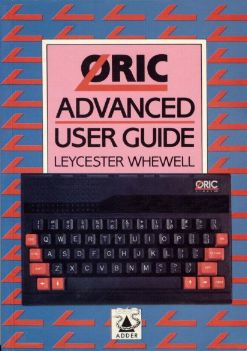BOOK REVIEW #5
![]()
Oric Advanced User Guide
by Leycester Wheywell
 |
INTRO. I was somewhat surprised
when I visited the book site, www.amazon.co.uk and
typed in ’ORIC’. The surprise was that I got a
hit. There was an Oric book available in 2000 ! That book
was the Advanced User Guide, one of the best and most
used of the Oric books. (There now seems to be some 39 books but most aren't available really.) THE BOOK. In some respects the title says it all. Unlike the Oric manual, or similar books, this is not a book for the beginner. It does not deal with how to plug the Atmos into a TV or how to take it out the box. From the offset the book is describing the function of the 6502. Later the book is dominated by a ROM disassembly , (V1.1 ROM), which makes up for around half of the book.. WHAT’S IN IT ? There are eight chapters and fourteen appendices. The first chapter introduces you to assembly language and the 6502 and it’s; instruction set. There is some good information here, but what is obvious is this book isn’t really for teaching you how to program. The information is there and the details are given throughout the book, from which you could learn sufficiently to be able to program - but it doesn’t explain things in quite the way you would if you were teaching. |
| I think this book is therefore aimed at
people who have some previous experience and so it gives
information they could use. Beginners could learn a lot,
but will probably struggle if they try and learn from
this alone. That said it is jam-packed with useful
information and detail on how to get the Oric under your
control. Chapters on graphics, sound and the 6522 interface very good with a wealth of information. I question why a chapter on the disk system is there. It offers nothing that didn’t come in the Microdisc manual so anyone that needs those details should already have them. So on to the main part of the book - the commented ROM disassembly. It is complete and the text tells you what each part is doing. An indispensable guide for anyone that needs to delve into the ROM. It’s a shame the V1.0 ROM wasn’t included, but there is Bob Maunders Oric-1 Companion which contains a V1 disassembly. You do find, later in the book comparisons of the different code locations in either ROM. E.g. CURSET is #F0C8 on the Atmos and #F02D on the Oric-1. Very useful if you want a program to work on both machines. Appendices give as much useful information as the rest of the book with pin connections for major chips, details of Page 0 and page 2 allocation which is useful to most people. For example, in page 2 is the location of start and end addresses of BASIC. To find these you PRINT DEEK (#2A9) and PRINT DEEK(#2AB) respectively. Similarly you can find the X,Y co-ordinates of the HIRES cursor by using PEEK at locations #219 and #21A. SUMMARY. For the serious user and those that dabble with programming, this is a must. It has often been said that this is the most used book after the Atmos manual. The amount of information contained within is outstanding and no other book is quite so comprehensive. Just get it OK ? Go on... have a look at Amazon and see if they have some left. It’s well worth it you know. Go on ! OK, I’ve got a spare if your not on the internet, so grab it will you can It’s got to be a 9/10 for this excellent tome !!!! |
|
© Copyright 2000 by S.D.Marshall email me